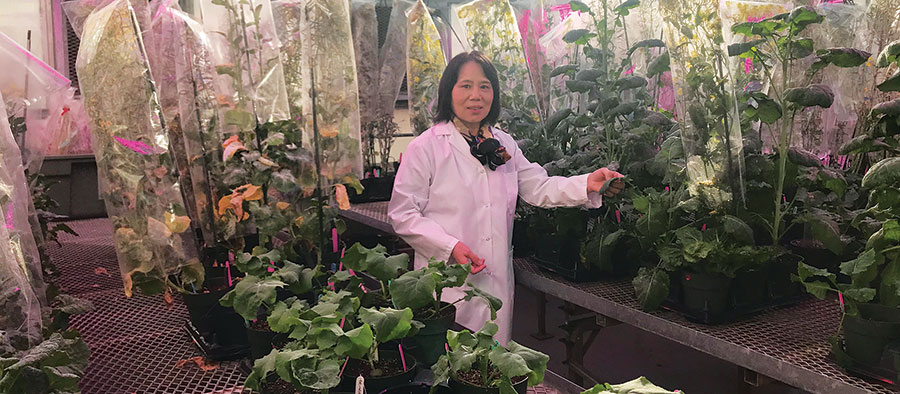Researchers expand the spectrum of clubroot resistance
Key result:
Canola lines with a broad spectrum of clubroot resistance were developed, which are valuable for developing resistant cultivars by canola breeders. Additional developments can improve the ability to monitor changes in the clubroot pathogen race structure, as the pathogen evolves in canola fields on the Prairies.
Project title, principal investigator:
“Defining populations of P. brassicae with near isogenic B. napus lines” Fengqun Yu, AAFC Saskatoon
Funding:
SaskCanola, Saskatchewan’s Agriculture Development Fund
Full report:
To find the full report, go to the Canola Research Hub at canolaresearch.ca
and search for the project title.

Clubroot disease caused by Plasmodiophora brassicae continues to pose a serious threat to canola production. Genetic resistance can be an effective strategy for clubroot management, but the sources available for resistance to clubroot in Brassica napus are limited.
This study aimed to develop a set of near isogenic B. napus lines containing single clubroot-resistance genes, and to define the populations of P. brassicae with the newly developed near isogenic lines.
Objectives of this project were to:
- Complete the development of the doubled haploid (DH) lines initiated in a previous project
- Develop a set of near isogenic spring type B. napus lines carrying resistance and define populations of P. brassicae collected in Western Canada.
Researchers used conventional breeding methods such as crossing and backcrossing, and molecular marker-assisted selection. Next-generation sequencing technologies were used for genetic mapping of clubroot-
resistance (CR) genes, which has greatly accelerated CR gene identification.
Results
Clubroot strains for the study were collected in canola fields in Alberta, Saskatchewan and Manitoba to define populations of P. brassicae in Western Canada. The research group also developed a highly efficient method for testing plants for resistance to clubroot.
Genetic mapping in several DH populations with introgressed CR genes from B. rapa turnips identified five novel genes. Researchers identified another gene from two mapping populations, one from European canola cv. Mendel and a second from introgressed B. napus lines originating from turnip cv. Siloga. This led to the development of canola DH lines with a broad spectrum of clubroot resistance derived from three sources
of turnips.
The DH lines, which were distributed to AAFC Clubroot Consortium members in April 2021, showed a high level of resistance to the majority of Canadian races of the clubroot pathogen identified in this study. These lines are valuable for developing resistant cultivars by canola breeders and for more robust strategies for disease management.
Researchers also developed a set of B. napus near-isogenic lines (NILs) containing single CR genes, which is ideal for differentiating races of the clubroot pathogen. This first set of NILs containing eight single CR genes in brassica crops could replace the current Canadian Clubroot Differential set and monitor race change in the pathogen race structure, potentially revolutionizing current clubroot pathotyping systems. The NILs can be used for genetic studies on the pathogen such as identification and cloning of the potential Avr genes, developing SNP markers associated with each of the Avr genes and providing information concerning the effectiveness of resistance.
Overall, the project resulted in the development of canola lines with a broad spectrum of clubroot resistance derived from three sources of turnips. Researchers also developed more than 1,200 DH lines for identification of novel resistant genes. Several breeding lines have been distributed to AAFC Clubroot Consortium members for development of future clubroot-resistant canola cultivars.





